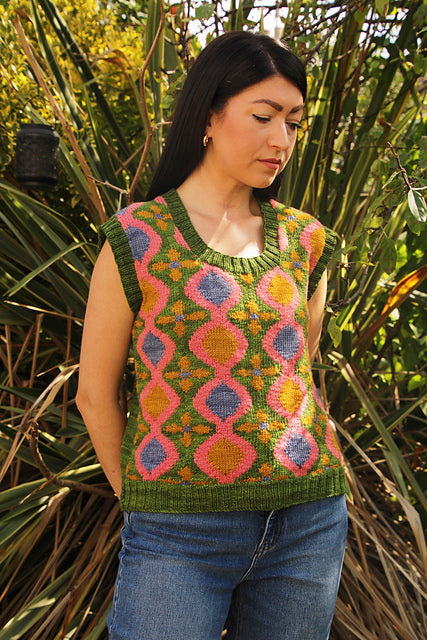Happy sorta-kinda spring, Knitters! Every month, we are more in love with our HerStory subject AND the colorway we create to honor them, and this month is only different in that we literally cannot stop looking at and dreaming of the yarn. It's so good that Shannon has already knitted an entire sock. We'll share photos on IG after the 25th of the month, when she will surely be done with the second sock.
April's honoree was a little heart-hard for us. We first heard about Maryam Mirzakhani when she passed away last year at the age of 40 from breast cancer. The fact that many Iranian newspapers, (and even the President) decided to share her photo, head uncovered, even though she didn't live by religious law, was really striking. This was a woman who had blazed so many trails in her 40 short years on earth that it was deemed more important to honor her than respect long-standing cultural taboos surrounding the rules her birth society imposed on women.
Maryam Mirzakhani was born in 1977 in Tehran, Iran. She quickly began to amass what would be a long list of mathematical "firsts": she was the first female student to receive the gold medal level in the International Mathematics Olympiad in 1994, and the next year, became the first Iranian student, either male OR female, to achieve a perfect score and win two gold medals. Her entire school and work career, she was blazing trails and breaking glass ceilings, y'all. After earning her BSc in Mathematics from the Sharif University of Technology in Tehran, she journeyed to the US, to Harvard, for her graduate work. She was a relentless and inquisitive learner, and didn't let the language barrier get her down. Her class notes were in Farsi; she communicated with her peers and professors in English. In 2004, she earned her PhD, and had fellowships at the Clay Mathematics Institute and a professorship at Princeton before finding her home at Stanford. It was there that she earned the singular honor of being both the first woman AND the first Iranian to win the prestigious Fields Medal mathematics prize (it's like the Nobel prize, but only awarded every four years, and primarily to mathematicians under the age of 40).
Mirzakhani's approach to math can be described as beautiful and (dare we say it?) crafty. When asked how she does her math thing, she referred to herself as a "slow" mathematician (others strongly begged to differ, changing the description "slow" to "deep"), and said that "you have to spend some energy and effort to see the beauty of math." Mirzakhani literally doodled her way knittedwit.com HerStory Sock Club April 2018 through mathematical figuring, filling huge pieces of papers with squiggly doodles and jotting equations along the edges, something her daughter described as "painting." Sounds pretty craftadjacent, doesn't it? She was known for her creative thinking and her ability to see the big picture, pairing seemingly disparate mathematical theories and approaches to solve long-standing mathematical problems.
The concepts behind what Mirzakhani studied make our brains literally hurt, but they also sound almost like magic. She studied the curves that sit on top of surfaces to understand the surfaces, things that are not bound by constraints of the REAL WORLD. What? In researching these theories and approaches, we were struck by the fact that the prevailing thoughts on mathematicians are that they are super boring and nerdy. In reality, after trying to get our heads around these concepts, it seems that they actually might be some of the most magical among us. It feels like it's all a big leap of faith to even approach a mathematical problem like the ones Mirzakhani was able to solve.
Mirzakhani was known for her studies of moduli spaces (which is where we got the name for the colorway from). From what we can gather and understand (which is not a lot!), a moduli space is a theoretical space consisting of solutions for geometric classification problems. The goal is to have a fine moduli space, where there is a unifying factor among the problems. And… that's about as far as we can go on that, because it's all pretty high-level mathematic theorizing, and, as we've said before, "Dammit, Jim! We're dyers and knitters, not mathematicians!" However, in the most basic understanding of moduli spaces, having a place where problems can more easily be solved by having at least one parameter in common sounds kind of dreamy, doesn't it? Finding common ground and all that jazz. Even if we are off the mark on our understanding of these concepts, we're feeling pretty good about it.
The colorway itself was inspired by the Nasir al-Mulk Mosque, otherwise known as the Pink Mosque in Iran. Seriously, check out this photo (https://www.flickr.com/photos/mayhlen/8094768919/), and try not to be immensely inspired by the overwhelming beauty of this space. We are tickled pink, blue, and yellow that our yarn came out to so perfectly match this amazing place. The mosque was built in the late 1800s, and features stained-glass windows that let in beautifully-colored light that in turn plays with the brightly-colored glass tiles that adorn the walls and ceiling. It is one of the most stunning buildings we have ever seen, and made the absolute perfect colorway to honor the trailblazing, amazing, and mind-bendingly brilliant Maryam Mirzakhani. We hope you are as inspired and touched by this HerStory as we were.
Remember to share your HerStory projects with us. Tag me @knittedwit, and use hashtags #knittedwit and #herstory2018kal. On Facebook, make sure to join our new Knitted Wit Knitalongs Group (https://www.facebook.com/groups/572482266432576), where folks have been sharing their HerStory projects so far. We have so many fabulous women to talk about with you, and hope you've loved the lessons so far!
Sassily yours,

knittedwit.com









